E a r t h /
m a t r i X
Science
in Ancient Artwork
The Octave:
Tuning at
A432 or F432
by
Charles William Johnson
A16 - A4096 |
Science in Ancient Artwork
Series Nº 70
New Orleans, Louisiana
| Introduction Pitch: A440 or A432 Tuning Pitch: A440 Tuning Pitch: A432 James Furia's Keyboard Tuning Pitch: A432 The A432 Keyboard of a Piano Divisions of the Keyboard A Distinct Notation for A432: F432-a256 The Scale of Pitch for Piano and Organ: A16 - A4096 Observations |
The Octave: Tuning at A432 or F432
Introduction
The perceived relationship between music and historically significant numbers finds scholars attempting to reconstruct ancient music. Pictorial art forms are registered on the walls of caves all over the world, reaching back tens of thousands of years. The art form of music does not enjoy such a distinct record; the notes and compositions seem to be lost forever. Yet, the very series of numbers coming out of the ancient reckoning systems are highly suggestive of a possible expression in music as well. Many scholars attempt to discern the traces of music and composition within the numbers and their relationships.
Two most recent examples have been examined in The Code, Carl P. Munck's newsletter. Munck cites William B. Conner's setting the standard tuning pitch of A440 at A492, and James Furia's suggestion that it be set at A432. (Cfr., The Code Newsletter, Numbers 34 & 35.) Personally, I am not musically inclined, muchless studied in the matter. Music has always been a spectator sport for me. Nonetheless, we shall examine how the numbers behave at the different settings of pitch for the piano, and the implications for the manner in which one might view the octave. One particular aspect of music theory that has always intrigued me is the manner in which letters of the alphabet are employed regarding notation. After writing this essay and studying the numbers, now I know why the letters always stumped me; their arrangement contradicts the numbers.
Pitch: A440 or A432
The first time I read that the piano was tuned at a pitch of A440 above middle C, I had no idea what that meant. The only thing that popped into my mind was that 441 was a significant number in ancient Egypt in relation to a 63c (thus related to the 756 count of Giza). An obvious alternative was 432, another historically significant number in many cultures ---meaning the Consecration-- but, that number seemed to be too far away from 440. With no music background it was difficult to know what implications might lie therein. Enter Munck's newsletter: Conner's proposal of 492 appeared which lay alongside the 432 figure as well; both were included on that scale. Then, James Furia suggested using the 432 figure alone.
The figure 432 is not far off from one of the previous figures used in music: 435. It was usual to employ the 435 pitch before the 440 pitch was accepted as the standard pitch. In 1917, the American Federation of Musicians accepted the A440 as standard pitch, and in 1920, the US Government then accepted it. It was not until 1939 that this pitch was accepted internationally. Before that, the pitch varied:
|
Since 1939, A440 is the pitch of choice for tuning a piano. Once the initial pitch is chosen, however, then the remaining strings must be tuned in accordance to that pitch based upon specific theoretical procedures. The remaining numbers (or other pitches of the remaining strings) are fixed by the nature of the very vibration of the strings. The rules of matter-energy make their appearance. The vibrations of the strings, and the frequency of their wavelengths, will either reinforce one another or cancel one another out, depending upon the relational pitch of each string.
The manner in which the setting of the strings' pitches is accomplished concerns the twelfth root of the number two (2). Manuals on tuning a piano, speak about beginning with the chosen pitch (i.e., A440), and multiplying it by 1.0594631 in order to achieve the corresponding theoretical numbers for the strings above A440 (which is the 49th key on the piano), and dividing the chosen pitch by 1.0594631 in order to obtain the numbers below it. That is the theoretical procedure for obtaining the numbers. Piano tuners are quick to state, however, that the numbers exist only in theory, as the numbers change for each, individual piano (with its own particular conditions of existence:old strings, humidity, etc.). The actual tuning of the piano appears to proceed in a rather distinctive manner running from A440 to C523, etc. We are interested in the theoretical numbers, not the actual tuning of the piano.
Let us look at the theoretical numbers given for the A440 tuning pitch:
|
Source: Reblitz.
On the first line corresponding to A440, one may observe how the numbers reflect the mediato/duplatio (halving/doubling) method, which we have been referring to throughout the Earth/matriX series as a distinctive computational method of mathematics within the ancient reckoning system. It is not surprising to find this method in relation to the tuning of the pitch for a piano. What is significant is to comprehend that the halving/doubling reflect reflects events of matter-energy; and, then recognize how numbers (1,2,4,8,16,32,64.128...) reflect nature. The fact that the ancient mathematical system employed the doubling/halving method of computation can only reflect an exact understanding of matter-energy; just as that same understanding appears to have been reflected in the design of the piano. The pentatonic scale, which is said to be over 4000 years old, would obviously be a reflection then of this same knowledge.
The obvious manner by which the theoretical numbers are obtained on the above table is by multiplying each A number by 1.0594631 successively and each corresponding product thereof in order to produce the particular numbers of each column. For that reason, the numbers from one column to the next are not exact doubles/halves of the adjoining numbers; also, the numbers have been rounded off for ease of viewing.
Tuning Pitch A432
Now, let us observe the proposal to set the tuning pitch for a
piano at A432, instead of A440. The numbers offered by Munck's newsletter
are a partial listing:
|
|
The actual number of keys on a piano's keyboard are 52 white keys and 36 black keys. From the start, one wonders exactly how much of the ancient reckoning system was carried over into Western society and culture. The number 52 is an obvious multiple of 26, and the two distinctive ancient reckoning counts were 260c and 360c. Furthermore, a note of intriguing wonder: 52 x 36 = 1872. The number 1872 is the fractal of the maya long-count period: 1872000 days since the beginning of time. One might find it difficult to even entertain the suggestion that Bartolomeo Cristofori, who built the first practical piano, may have had such symbolic numbers in mind. Or, that 52 and 36 reflect the two variations of perfect right triangles at their baseline numbers: 48:52 and 36:64, as we have examined previously (Earth/matriX Nº 67). Such a symbolic representation may have been in tribute to the study of music exercised by the Pythagorean school, which concentrated on the relationship of perfect right triangles. Nonetheless, the numbers of the perfect right trinagle and their variations are in the numbers of the tuning of a piano, irrespective of which particular pitch one wishes to work with.
Let us, then, observe the complete numbers for the setting of the piano's pitch baseline at A432, as suggested by James Furia.
The A432 Tuning Pitch for a Piano |
||||||||||||||||||||||||||||||||||||||||||||||||||||||||||||||||||||||||||||||||||||||||||||||||||||||||||||||||||||||||||||||||||||||||||||||||||||||||||||||||||||||||||||||||||||
| ||||||||||||||||||||||||||||||||||||||||||||||||||||||||||||||||||||||||||||||||||||||||||||||||||||||||||||||||||||||||||||||||||||||||||||||||||||||||||||||||||||||||||||||||||||
The previous table was obtained by multiplying the baseline numbers A27 by the twelfth root 2 (1.059463094) successively thereupon its own column, then, rounding those numbers off to two decimal places, and then, doubling each number along its corresponding line. The second listing on the table shows the numbers rounded off to only one decimal place. These numbers would not necessarily be useful to someone attempting to tune a piano, since possibly the beats would not be distinguishable, but they are simply theoretical numbers for the pitches.
How would the numbers actually play ? That would have to be a task for someone like James Furia himself to distinguish possibly; if the numbers are any reflection of sound, there appears to be a wealth of purity involved as the numbers easily complement one another which suggests "constructive interference" as it is termed. The numbers do vary from those proposed by Munck/Furia in the newsletter. These adjustments appear to be more acceptable in terms of method and meaning.
|
The distinct pitches, observed in the previous manner, would suggest a complete picture of the keyboard. In fact, it may appear logical that the keyboard begin with A27 (a prime divisor or 432)
Yet, the number 27 points to something quite interesting regarding the pitch of a piano and an organ. In the manual on tuning a piano, reference is commonly made to the lowest key possible of a 16 pitch, achieved in a 32-foot open pipe, or in a 16-foot closed pipe. In order to consider the pitch of 16, let us observe the natural divisions suggested in the A432 (or A440 as well) keyboard:

From the perspective of the specific musical instrument, the piano, it would appear logical that the notation of letters begin with the letter A at the pitch 27 (A27). Yet, still another consideration may be in order . The lowest possible pitch for organ (and piano ?) is that of 16, as we have seen above. Therefore, it would seem to be acceptable to understand the numbers and the lettering notation as of A16, and not A27. This would be the similar relationship pointed out earlier regarding A430:C256hz and A427:C256hz, which were older tuning baselines.
A Distinct Notation for A432 : F432-A256
If we commence the pitch scale with A16, instead of A27, then the theoretical numbers appear to be self-explanatory. Furthermore, the baseline pitch beginning with 16 reflects the natural number progressions as of the unit one:
The chosen scale baseline for the organ/piano is physically encompassing the pitch scale 16 - 4096; its lower and upper limits. One could easily comprehend the need for the notation of letters to follow that same scale of numbers:
 |
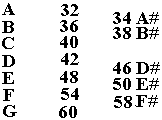 |
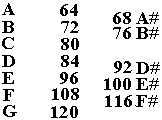 |
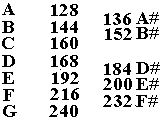 |
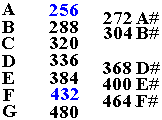 |
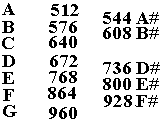 |
 |
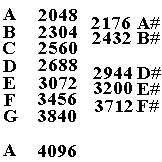 |
One may understand that A440 (and its variations of pitch), that is, the 49th key of the piano's keyboard was chosen as a physical starting point for tuning the piano. The commencement of the tuning exercise somewhere around the middle of the piano's keyboard would assist in avoiding a deviation towards the outer limits of the keyboard itself. If one were to begin tuning at the lower or upper limit of the keyboard, then any error would be greatly increased as one approached the other end of the keyboard itself. A materially physical reason may have established the need for starting the tune-up somewhere in the middle (A49). But, the theoretical make-up of the numbers would require a distinct criterion in relation to the vibration of the strings themselves (A16), an apparently natural limit of this particular instrument.
Currently, the notation of letters would appear to follow the reasoning behind the requirements for tuning the piano, and not the reasons behind the theoretical relationship of the strings. In a sense, there exists a contradiction of terms among the notation, the vibrations of the strings, and the requirements for physically tuning the piano. Inspite of that, undoubtedly incredible music has been created through sound; ultimately, music has been created without the notation or the theory, based on sound alone.
Observations.
The A440 pitch is generally employed in tuning a piano. This particular baseline for the scale has been accepted since 1939; undoubtedly, such a practice may not vary for a long time. Inspite of that, musicians are quite inventive and they experiment with distinct arrangements;that is the creative nature of music itself. The A432 pitch has been suggested by James Furia as a possible alternative for tuning a piano. Before the A440 pitch was accepted, the A435 pitch was common; to propose the 432 pitch does not seem to be that radical, and lies within the possibility of creating music obviously.
The most pleasant aspect of choosing A432 as a baseline for the piano's tuning pitch is that the theoretical numbers that derive from this procedure reflect historically significant numbers of the ancient reckoning system from around the world. One has only to consider some of the numbers listed in this essay on the A432 table in order to observe their similarity with numbers cited in other Earth/matriX essays. The same complementary nature of the numbers coming out of the ancient reckoning systems may be observed with regard to the series of numbers for theoretical pitch on the A432 scale. Music deals with the complementary and constructive interference of the vibration of the strings; the numbers and their complementary nature reflect just such a possibility. An obvious conclusion is that the numbers of the ancient reckoning systems could easily produce musical sound on the piano ---no matter which particular pitch may be chosen--- because the numbers of both systems behave the same way.
In this essay, we have shown that in order to allow the theoretical discussion of numbers to be more theoretically comprehensible, one would probably have to adjust the universe of the numbers (from A16 - A4096), and therefore adjust the system of notation of letters, as such:
|
||||||||||||||||||||||||||||||||||||||||||||||||||||||||||||||||||||||||||||||||||||||||||||||||||||||||||||||||||||||||||||||||||||||||||||||||||||||||||||||
By employing the 432 pitch for A, the numbers of all the other strings would appear to be easily relational. By interchanging the notation of letters, the manner by which the numbers may be related become even easier than normally comprehended. In this regard, a few more essays may be in order to illustrate how the numbers and the notation work together. The system of pitches F432 - A256 (or, previously notated as A432 - C256) reflect the general universe of the octaves A16 - A4096, the complete gamut of organ/piano tuning. Within those series of numbers, the historically significant numbers of the ancient reckoning systems become evident. The idea that the ancient reckoning system may be susceptible to a translation in music would not appear to be something outside the realm of musical creation.
Reproduction prohibited without written consent of the author.
Your comments and suggestions are greatly appreciated:
e-mail: johnson@earthmatrix.com
Science in Ancient Artwork
The Octave: Tuning at A432 or F432
Series Nº70
18 August 1996
©1996-2013 Copyrighted by Charles William Johnson. All Rights Reserved
Earth/matriX,
Reproduction prohibited without written consent of the author.
| Home | Books | Author | Site map |

